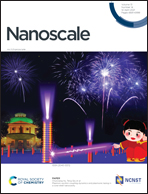Photoinduced charge-transfer in chromophore-labeled gold nanoclusters: quantum evidence of the critical role of ligands and vibronic couplings†‡
Abstract
The electron flow between a metallic aggregate and an organic molecule after excitation with light is a crucial step on which hybrid photovoltaic nanomaterials are based. So far, designing such devices with the help of theoretical approaches has been heavily limited by the computational cost of quantum dynamics models able to track the evolution of the excited states over time. In this article, we present the first application of the time-dependent density functional tight-binding (TD-DFTB) method for an experimental nanometer-sized gold-organic system consisting of a hexyl-protected Au25 cluster labelled with a pyrene fluorophore, in which the fluorescence quenching of the pyrene is attributed to the electron transfer from the metallic cluster to the dye. The full quantum rationalization of the electron transfer is attained through quantum dynamics simulations, highlighting the crucial role of the protecting ligand shell in electron transfer, as well as the coupling with nuclear movement. This work paves the way towards the fast and accurate theoretical design of optoelectronic nanodevices.



 Please wait while we load your content...
Please wait while we load your content...